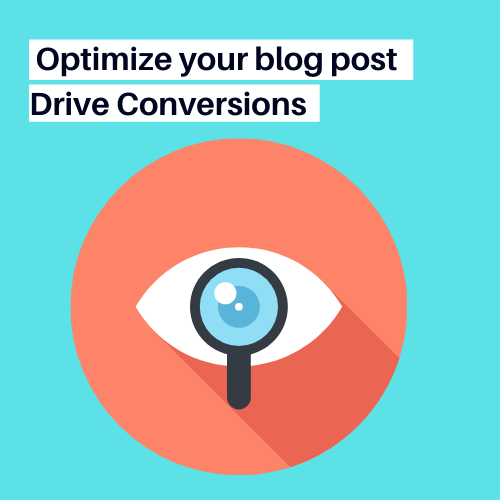
As a business owner, having powerful content for your customers to engage with your brand is an important part of your online presence and customers relationships. This step-by-step guide will help you create, write, and optimize your blog content to drive more traffic and increase conversion.
In this blog post you will receive 17 ways that if followed can turn your average blog post into a piece of important content on your companies site and that will drive your customers to convert Within this post you learn about:
- Finding the right topic ideas
- Planning your post around important keywords
- Understanding what your customer is looking for
- How to focus on the introduction
- Writing memorable headlines
- Optimizing your headings
- How to optimize your title tag and meta descriptions
- Choosing tags and categories properly
- How to use opening loops
- What easter eggs are and how to hide them
- What images to include
- How to beat your competitors in blog content
- Different types of rich media you can use
- How to structure your content
Finding topic ideas
Not having ideas for blog posts can slow down the content process. In order to find the right topics there are a variety of places you can look.
- Quora: Go to Quora and search your key term. Example “physical therapy” by searching this you will find an entire list of common asked questions that people need answers to. Use those questions to craft blog post topics
- Google: Go to google and type in your primary keyword and see if there are featured snippets or common asked questions that you could base your blog post on
- Buzzsumo: This is a place that lets you find viral content
- You can choose specific articles, content, or infographics that you see is already working and put it in your posts
- Competitors: Look at what your competitors are writing about and see if you can use them as inspiration
- Google Trends
- Google trends allows you to see what the world is searching for and what is trending. You can search specific topics like physical therapy to see what is the most common topics people are looking for.
- Google News
- Google news provides current news that allows you to stay relevant within your industry. This is a great resource to search for current news in your industry and be one of the first to be writing about it.
- Related Terms (bottom of Google Search)
- After searching for key terms on Google you can scroll all the way down to the bottom of the page where you will find “related search terms” This is a great place to look for similar topics that people are also searching for.
Planning your post around important keywords
Determining what keywords you should be writing your post around is the most important aspect when it comes to content creation. A few great places to determine what keywords you should be using include:
- Keywords your competitors are ranking for and writing about
- Google searches that tell you what others are frequently asking
- What featured snippets or Google questions this topic has for it
- If you are trying to rank a specific landing page – what keywords is that page centered around.
- Lastly what keywords are you trying to rank for and do they relate to the topic of the post?
Example of a Featured Snippet:
Understand what your customer is looking for
Use search console, google analytics, and other data research to see what words people are searching for to find an answer to their question. You want to optimize your blog post for what they are trying to find the solution for. You also want to meet the customer where they are in the buyer’s journey. Depending on if they are a brand new customer who has never heard of you before or already familiar with your brand you want to make sure the content you are presenting to them is relevant. A strategy you can use to create content made for your buyers journey is TOFU, MOFU, BOFU:
- TOFU (Top of Funnel)
- Building awareness about your services/ the problem you address
- Blog posts
- eBooks
- Building awareness about your services/ the problem you address
- MOFU (Middle of Funnel)
- Teaching your customer how to choose a solution
- Case Studies
- EBooks
- White papers
- Webinars or Podcasts
- Video tutorials
- Teaching your customer how to choose a solution
- BOFU (Bottom of Funnel)
- Explaining why your product is the best solution
- Free trial
- Free consultation
- Urgency Offers
- Explaining why your product is the best solution
Focus on the introduction
The initial sentence should be short, punchy, and create lots of curiosity. Remember you only have 2.7 seconds to grab your customers attention before they click off your page. Out of all the content they view everyday make sure yours stands out from the crowd and the intro is the most important part.
Five classic ways to open a blog are:
- Start with a readers questions
- If your blog post is answering the readers question make sure to start with the question and possible answers that could be answered by reading.
- The success story
- Pull the reader in by telling them a successful story that would make them want to also be that success story.
- Example: The success of physical therapy on a specific type of injury
- Pull the reader in by telling them a successful story that would make them want to also be that success story.
- The what if
- Paint the story to the reader of the “what if” situation.
- Example “What if physical therapy could take away your chronic pain without medication”.
- Paint the story to the reader of the “what if” situation.
- The pain vs. gain
- Start by building up pain, empathy that your audience can relate to. The more you build the story the more compelled the reader is to continue with the article.
- The exchange
- Start by telling the reader the exact benefit they will receive in exchange for what you are offering and then provide them the solution by promising the benefit in exchange for reading.
Write memorable headlines
The title should always contain the primary keyword. Headlines should make the reader “have to read the rest” This is similar to your introduction. You want to make sure that when the reader sees your headline they want to read the paragraph underneath. When writing headlines think about the following:
- Use the words that describe the topic in your blog title. Avoid ambiguity.
- Ask yourself the question, “If I were a member of my audience, why would I read this blog post instead of any others like it? Why?” Then, like a little kid, go down the why rabbit hole to get to the core value you’re providing to your readers.
- Just like you would with marketing a product, define the value proposition for your blog posts and include that in your blog titles.
Examples of well written blog post titles
Optimize your headings
Look for opportunities to (naturally) include your keywords in the page heading. That includes anything that has a <h1>, <h2>, or <h3> tag on the page. These are special headings that are larger than the normal text and tell Google that this is what your post is about. You can see the image below for examples. Headings are often a good place to add in similar core words that your blog post is about (see words highlighted in yellow as examples).
Examples of headers:
<H1> or Primary Keyword: Winter Activity Injuries: What Can Happen to Those Who Aren’t Careful Outdoors in the Cold
<H2>: Injuries while playing winter sports
<H3>: Who really likes winter weather?
Examples of different headings:
Image from SEOranking
Use Relevant Internal Links
Each time you write a new post, think about any blog posts you’ve already published that are relevant to what you’re writing now. Wherever it makes sense to do so, add in those links and If you can do so naturally, use anchor text that relates to your target keyword for the older post you’re linking to. Another part of internal linking is driving your reader to convert on your website. Add a call to action link that drives the customer to a landing page where they can schedule an appointment.
Optimize your title tag and meta description
Make sure to use your target keyword in your title tag and meta description. Your title tag and meta description are what is displayed when your web page is displayed on Google. The goal of your title and description is to motivate someone finding your page in Google search to click on your link and drive them to your website. In order to get people to click through to your page make sure your meta description has a clear call to action or answer to their problem – how are you solving what they need. Make a compelling offer that will make them click to your page and is different from the competitors title and description.
Your title tag should be within 50-60 characters long and the meta description should be between 50-160 characters. Sometimes Google does not show all of the meta description in searches so you want to make sure that the first three lines of the meta description are the most important thing that will make a reader click to your blog post. These sentences will tell the reader what your post is about and if it relates to what they need make them click on it.
Choose tags and categories properly
Blogs allow you to create tags and categories that help you group related posts together. This is both a useful navigational aid for people browsing your blog and a tool you can use strategically for SEO. Every category or tag you use creates a new page that will include the name of the tag or category in the URL, along with a lot of relevant content and links on the page.
Opening loops
Give a cliffhanger to the audience by opening loops in your blog posts that poses a question or points to giving more information later in the article.
- Example: “As you’ll see in just a second you will become a pro at this industry”; Makes the reader keep reading
Hide Easter Eggs
An easter egg acts as an inside joke the target audience would bond too, something the reader doesn’t need to understand but would make your target audience think this piece of content was made specifically for them.
Include Images
A good blog post should always have images associated. Images should have proper image alt tag and image description that relate to the keywords your blog post is trying to rank for. Also make sure to always use commercial use images in your posts. Try not to use free stock images. Google is looking for unique images that do not appear anyplace else on the web.
Understand your competition
If you are trying to outrank your competition for a specific blog post topic make sure you are using more text than they are, more images than they are, etc. If they have 500 words you should have at least 501 words.
Using Rich Media
When it comes to rich media there are a variety of different types you can add to your blog posts to increase the value it brings to your reader. Some types of rich media include videos, infographics, GIF’s and Guides/PDF’s.
Focus on the closing
You always want a call to action when closing your blog post that can drive them closer to scheduling an appointment or learning about your clinic. Leave them wanting more – linking to other posts that have a relevant topic is a great way to drive customers deeper into your site and thinking of your business as providing value.
At the end of the blog post make sure that you give the reader a summary of the entire post with the most important information you want them to walk away with. Once you provide your summary you will want to end with a compelling ask which will try and drive the reader to schedule the appointment or contact your clinic.
5 Examples of blog post closings:
- Close + Offer: Tie your closing into one of your offers and something the reader can do
- Ask for more input: This could be asking the writer to comment/share on social media
- Tell people what to do now: Tell the reader what to do next by asking them to contact your office, schedule an appointment, fill out a form, or read another similar post
- Ask for a response: Ask them a specific question like “When playing sports what is your favorite PT exercise?”
- Remind the readers of the original promise: Circling back to the beginning can help close the loop and help the reader feel like the blog post delivered on your promise.
Add Social Share Buttons
Make it easy for your customers to share your content. There are a variety of plugins or tools that you can use to add this to your blog post easily and cost-effective. One of our favorite plugins for social sharing are the Socialwarfare plugin.
Structure the content properly
Nobody wants to read a massive paragraph of text. The easier you make the blog post to read the easier it will be for google to read as well. A few ways to structure your blog post is:
- Use headers inside of your blog post with prominent keywords to break up paragraphs
- Include bullet points, and numbered lists
- Bold and italicize important words you want your reader to find
- Make your paragraphs short and sweet not drawn out
Have a clear Call-To-Action
Your blog post is what got the customer to the page but how can we take advantage of that? How can you drive the customer towards a purchase or staying on your site?
In order to do this you want a clear CTA. This can be placed in the following locations:
- Sidebar CTA or opt-in
- End of post CTA or opt-in
- Pop-up CTA or opt-in
- Banner sending them to a dedicated landing page

